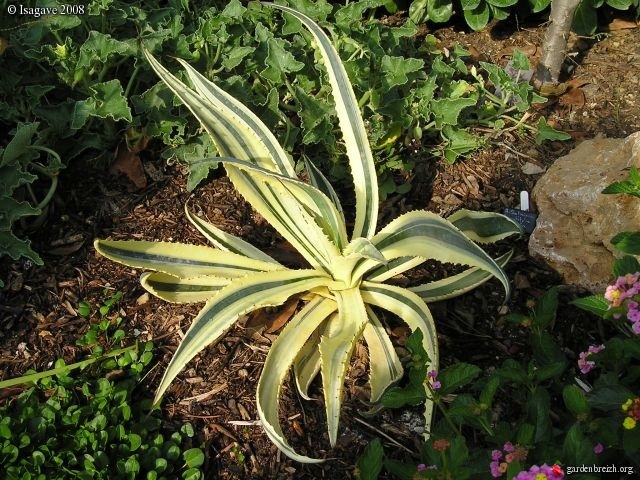Isa a écrit :Quelle salade...

Oui c'est rien de le dire !
Ce "tecta" enfin sigmatophylla est encore jeune, ses feuilles sont courtes, par contre j'ai mesuré l'épine terminale qui fait presque 7 cm.
Et les épines de salmiana font de 5 à 10 cm de long

As-tu une photo du vrai tecta Gimli stp ?
Voici la description originale :
Agave tecta n. sp.
Acaulescent, suckering. Leaves grayish green, broadly oblanceolate or at first almost obovate, ascending, the gradually subacuminate apex sigmoidally upcurved, conà‚¬cave, valleculate above, smooth, becoming 50 x 200 cm.; spine purple-chestnut becoming gray, dull, smooth, conà‚¬ical or subacicular, often compressed, slightly flexuous, shallowy grooved below the middle, 5-7 x 45-65 mm., long-decurrent, somewhat intruded dorsally into the green tissue; teeth similarly colored, more or less polà‚¬ished, 40-70 mm. apart, about 8 mm. long, recurved, the triangular often curved cusps abruptly dilated into low-bases 15 mm. or more wide, between which the smooth margin is nearly straight. Inflorescence 5-6 m. high, the upper half ellipsoidally paniculate with slightly asà‚¬cending branches; bracts broadly triangular, densely imbricated so as to cover the scape completely, those of the panicle reduced and spreading: pedicels thick, 5-10 mm. long. Flowers yellow, about 70 mm. long; ovary 30-35 mm. long, about equaling the perianth, obà‚¬long; tube openly conical, 10-15 mm. deep; segments about 20 mm. long, shorter than the ovary; filaments inserted about the middle of the tube, some 40 mm. long. Capsules (immature) oblong, some 30x60 mm. Apà‚¬parently not bulbiferous.
Specimens examined: Guatemala. About Quezaltenango (T release, 17â€â€the type, in the herbarium of the University of Illinois; 18, both in April, 1915).
Known to me only as planted in hedge-rows, sparingly in the vicinity of Mixco, between Antigua and the capà‚¬italâ€â€and in gardens in the latter, but abundantly in and about Quezaltenango, north of which it is said to occur wild in the mountains. Evidently of the group Atrovirentes, to which the pulque species of Mexico belong,â€â€ the type of which, A. atrovirens, like Furcraea longaeva, was described from Mt. Tanga in southern Oaxaca.
Though pulque is now unknown in Guatemala, Fuenà‚¬tes y Guzman, "regido perpetual de la ciudad de Goathemala," records that excellent pulque was produced at Atmolonga or Ciudad Vieja and at San Gaspar two cenà‚¬turies ago;* but there remains no evidence of it that I have been able to discover unless it be in these scatà‚¬tered hedge-rows of Agave tecta.[/quote]
Et la figuration originale
in Trelease, 1915:

Le document n'est terrible mais c'est tout ce que j'ai trouvé.
Et voici les figurations de Gentry 1982:


Désolé là aussi mon scanner ne marche plus. C'est dommage j'auris fait des images plus grandes. Sinon, e suis sans doute comme vous je commence à ne plus y comprendre grand chose car ça resemble à certaines formes massives interprétées comme des salmiana !????
Pour le fun (c'est pas le mien), un autre identifié comme Agave salmiana x angustifolia medio picta aurea (avec quelques réserves), j'avoue que là je nage...
Ahhhhhhhhh! Mais je l'ai celui là ... mais sans nom :


. Donc ce serait son pédigré , pas mal !

Au fait j'ai trouvé un picta panaché ... à l'envers


cad jaune au milieu de la feuille !
On est obligé d'étiquetter les Agaves ???


C'est pire que les palmiers !
A midi je suis allé mangé mon sandwich au Mont Boron, entre Nice et Villefranche/ Mer dans un coin ou un jour j'avais repéré des Agaves. Je vais faire un post spécial parce qu'au niveau salmiana ou assimilés.......



On se croirait au Mexique !




















